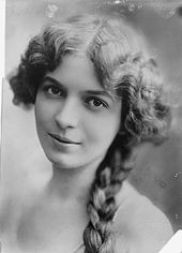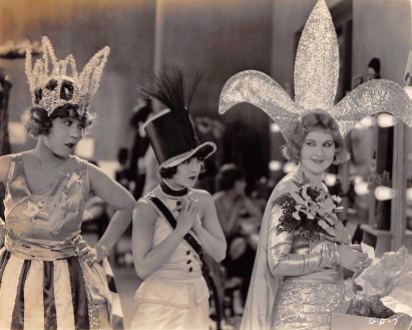
The Gold Digger films are often characterized as the quintessential 1930s musicals. Typically featuring a backstage musical formula, the films usually tell the story of the relationships and conflicts that occur during the production of a musical. While musical numbers occur along the way, additional fantastic and intricate musical numbers showcase Busby Berkeley’s choreographic skills in numbers that stray from the plot. Though the Gold Digger films typically conjure up images of Dick Powell, Joan Blondell, or Ruby Keeler, the films possess an interesting history that includes a wide range of talents and plot lines.
Long before the 1930s films were being produced, the genesis of the films came from a 1919 play called The Gold Diggers, by Avery Hopwood. This play popularized the term “gold digger” in reference to women who sought wealthy partners. Broadway producer David Belasco staged the farce with Ina Claire in the lead role, premiering the show on September 30, 1919, at the Lyceum Theatre. There, show show became a hit, running for two seasons in a row until June 1921 for 720 performances, prior to going on tour throughout the United States until 1923.
The full cast for the Broadway play included the following actors and roles:
| Character | Broadway cast |
|---|---|
| Jerry Lamar | Ina Claire |
| Wally Saunders | Horace Braham |
| Sadie | Louise Burton |
| Gypsy Montrose | Gladys Feldman |
| Mrs. Lamar | Louise Galloway |
| Eleanor Montgomery | Luella Gear |
| Tom Newton | William Goodridge |
| Mabel Munroe | Jobyna Howland |
| Cissie Gray | Loraine Lally |
| Freddie Turner | Day Manson |
| Stephen Lee | Bruce McRae |
| Marty Woods | Arthur Miles |
| James Blake | H. Reeves-Smith |
| Fenton Jessup | A.E. Scott |
| Trixie Andrews | Lilyan Tashman |
| Topsy St. John | Ruth Terry |
| Barney Barnett | Frederick Truesdell |
| Dolly Baxter | Katharine Walsh |
| Violet Dayne | Beverly West |
The play tells the story of a wealthy man named Stephen Lee who is convinced that the chorus girl engaged to his nephew is a “gold digger” and that she is interested only in his nephew’s money. In response, Lee confides in Jerry Lamar, another chorus girl, and asks her to convince his nephew to break the engagement. However, Lamar instead tries to convince Lee that not all chorus girls want money. While this may be the case, many of Lamar’s friends prove Lee’s fear to be true, as they appear to be money-hungry. Agitated with Lee, Lamar decides to make him appear foolish by getting him drunk and tricking him into proposing to her. In the end, her scheme causes no harm when the Lamar and Lee realize that they truly are in love with one another.
The show opened to mixed reviews, being critiqued as having moments that were humorous as well as moments that were dull. Another critic claimed that the show was vulgar and immoral in addition to giving the wrong impression of chorus girls. Nonetheless, the show was a hit and opened the door to success for its playwright, Hopwood; at one point, Hopwood had four shows running on Broadway simultaneously.
By 1923, The Gold Diggers was taken to the silver screen and adapted as a silent film. Based upon Hopwood’s play, both the silent film and play were produced by David Belasco. The film was produced and distributed by Warner Brothers, directed by Harry Beaumont, and released on September 22, 1923. Once filmed and edited, the feature was a total of 80 minutes in length.
The film’s plot is very similar to the plot of the play. Wally Saunders wishes to marry chorus girl Violet Dayne; however, his uncle, Stephen Lee, thinks that all chorus girls are gold diggers. Lee refuses to approve of the marriage. Dayne’s friend Jerry La Mar is not a gold digger, but she agrees to pursue Lee aggressively enough to make Violet look tamer by comparison. In the end, Lee and La Mar fall in love and get married. They remain in love even after he discovers the truth. Lee gives his permission for Dayne and Saunders to marry.
The film featured a cast which included:
|
|
Although some modern sources credit Louise Beavers with appearing in this film, such is not the case; Beavers appears in the 1929 remake.
Overall, The Gold Diggers (1923) was a success, grossing $501,000 at the box office after being filmed on a $280,000 budget.
Today, The Gold Diggers (1923) is believed to be lost.
UPDATE: As of May 2021, portions of The Gold Diggers (1923) have been FOUND! A collector found incomplete Belgian 35mm nitrate prints, which have since been uploaded to YouTube. The discovered footage includes what was part of reels 1, 4, 5, and 6, for the film.
In June 2021, the same collector delighted classic film fans once again by sharing a digitally scanned version of the first five minutes of The Gold Diggers (1923) to YouTube, with plans to do the same with the rest of the located footage.
Film historians, classic film fans, archivists, and collectors always dream of receiving good news such as this. It is my hope that many more presumably lost features are located and restored.
Read my full series on the Gold Digger films here:














